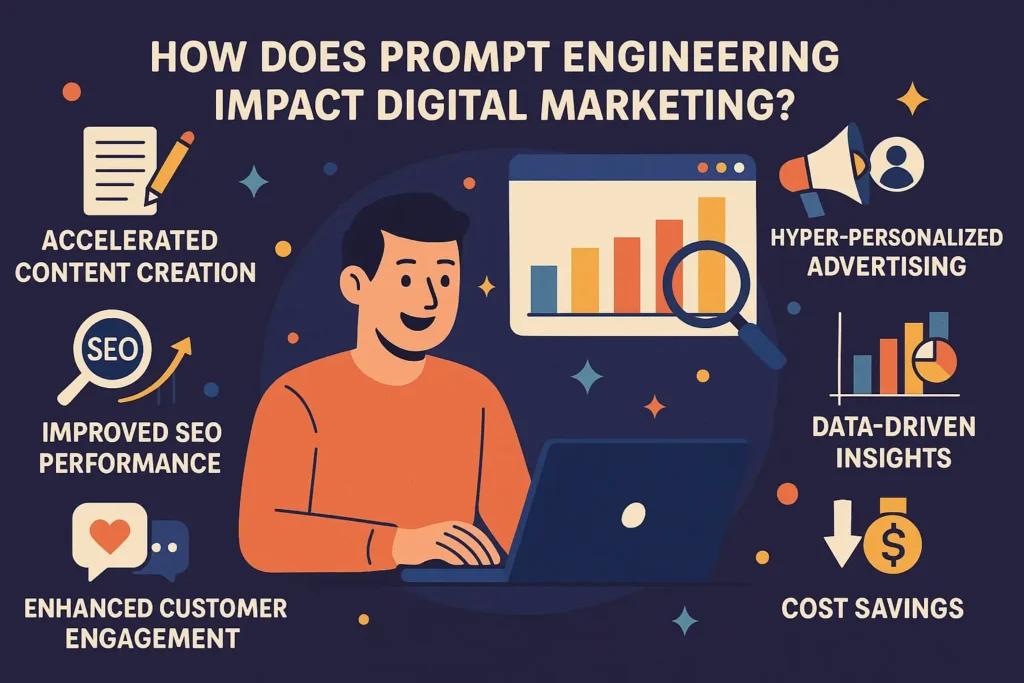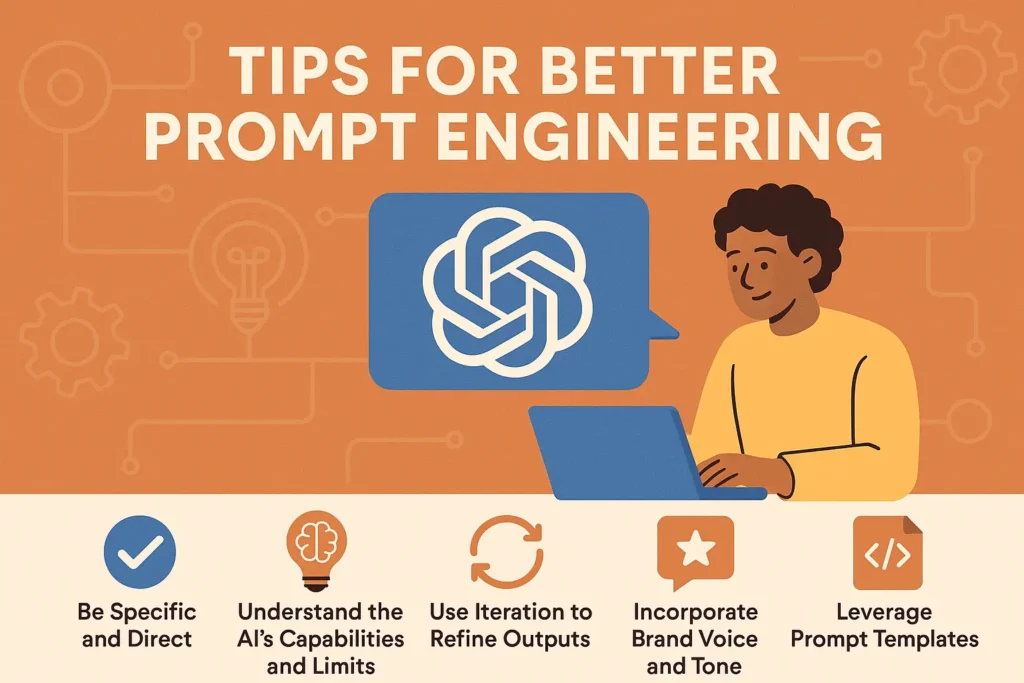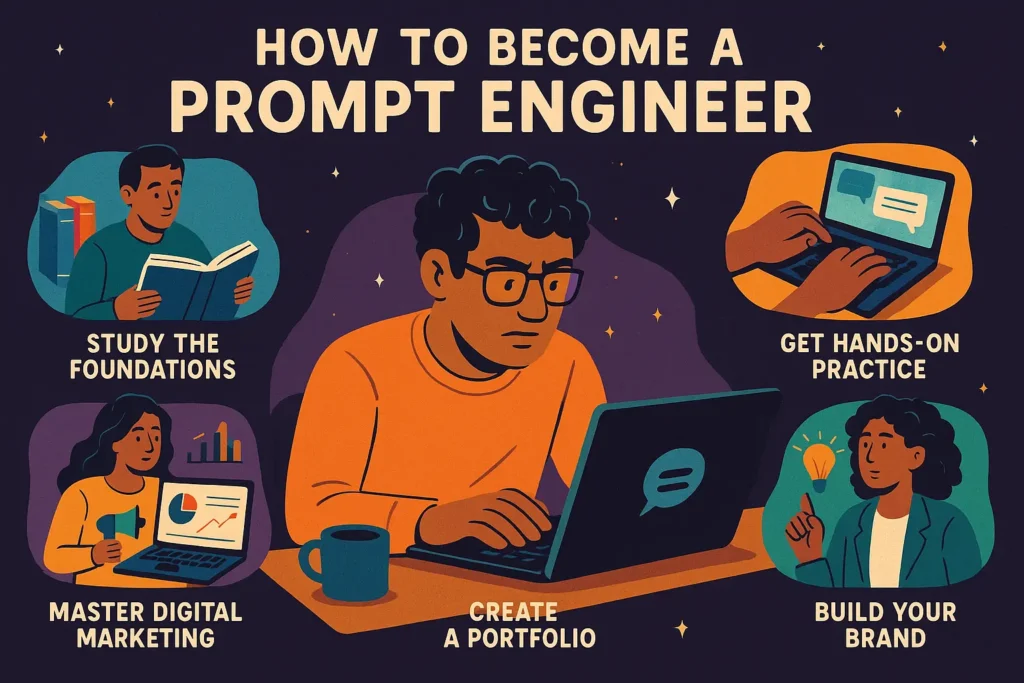Staying ahead of the curve means embracing innovation in the rapidly evolving marketing world. One of the most transformative developments in recent years is AI prompt engineering for marketing. With the popularity of generative AI tools like ChatGPT, Bard, and Midjourney, understanding prompt engineering isn’t just a bonus—it’s becoming a necessity. In fact, prompt engineering for digital marketing is now regarded as one of the most valuable skills marketers can learn to maintain a competitive edge.
Prompt Engineering Essential Insights
What Is Prompt Engineering?
Prompt engineering is the art and science of designing effective inputs—called prompts—to guide the behaviour of generative AI models such as ChatGPT, Bard, Claude, and Midjourney. These models respond to natural language prompts by producing relevant outputs like text, code, images, or data insights. A well-structured prompt ensures that the AI delivers content that is specific, accurate, and aligned with your intent.
Think of prompt engineering as talking to a knowledgeable assistant who can do almost anything—if only you know how to ask the right question. In digital marketing, where creativity, clarity, and context matter, mastering prompt engineering can transform how marketers approach tasks ranging from SEO content writing to personalised ad creation.
Example:
- Poor prompt: “Write a marketing email.”
- Engineered prompt: “Write a persuasive, 150-word marketing email promoting a 20% discount on eco-friendly yoga mats to millennial women. Use a friendly tone and include a clear CTA.”
How Does Prompt Engineering Impact Digital Marketing?

Prompt engineering for digital marketing unlocks new levels of efficiency, personalisation, and creativity. Here’s a breakdown of its key impacts:
1. Accelerated Content Creation
Using generative AI models guided by intelligent prompts, creating blogs, emails, landing pages, and social media posts becomes faster and more efficient. In seconds, you can generate entire content calendars, repurpose existing content, or localise copy for different regions.
2. Hyper-Personalized Advertising
Using prompt engineering generative AI for marketing & advertising, brands can create ad variations tailored to specific customer segments. For example, prompt-engineered tools can craft Google Ads, Facebook captions, or YouTube video scripts that speak directly to your ideal customer persona.
3. Improved SEO Performance
AI tools trained with specific prompts can generate SEO-optimised content, including high-intent keywords, meta descriptions, and schema markup. Prompt engineers can request keyword analysis, competitor research summaries, and FAQ-rich content to boost search rankings.
4. Data-Driven Insights
With the right prompts, generative AI can summarise market trends, analyse customer behaviour, and interpret analytics dashboards. This helps digital marketers make quicker, smarter decisions based on actionable insights.
5. Enhanced Customer Engagement
AI chatbots and automated support systems rely heavily on well-engineered prompts. You can guide these tools to handle queries, complaints, and onboarding flows with a tone that fits your brand.
6. Cost Savings
By mastering AI prompt engineering for marketing, businesses can reduce reliance on large teams for routine content and automation tasks, saving both time and money while maintaining quality.
Tips for Better Prompt Engineering

To unlock the full potential of AI in digital marketing, follow these best practices:
- Be Specific and Direct: Avoid vague prompts. Include specific tasks, tones, lengths, formats, and even example outputs if possible.
- Understand the AI’s Capabilities and Limits: Know what your AI tool is trained to do. For instance, ChatGPT excels in writing, brainstorming, and summarising, while Midjourney is tailored for visual design.
- Use Iteration to Refine Outputs: Don’t settle for the first response. For better results, reword your prompt slightly, add new conditions, or split tasks into smaller steps.
- Incorporate Brand Voice and Tone: Embed brand identity into prompts. Example: “Write this post in a bold, Gen Z-friendly tone with emojis and hashtags.”
- Leverage Prompt Templates: Create reusable templates for repetitive marketing tasks like email sequences, blog outlines, and social posts.
Prompt Engineering Techniques
Mastering these techniques can elevate your prompt engineering for the marketing game:
- Zero-Shot Prompting: Give no examples—just ask. Ideal for straightforward tasks like definitions or summaries.
- Few-Shot Prompting: Provide 1-3 examples to help the AI understand the desired style or logic. This is great for storytelling or formatting tasks.
- Chain-of-Thought Prompting: Encourage step-by-step reasoning. Especially useful for data analysis, decision trees, or troubleshooting.
- Persona-Based Prompting: Have the AI respond as a fictional character, industry expert, or your brand. This ensures voice consistency and deeper engagement.
- Prompt Chaining: Link multiple prompts for sequential tasks. For instance, first generate an outline, then a draft, then a CTA.
Prompt Engineering as a Career
The demand for prompt engineers is soaring as AI becomes central to marketing. Professionals who understand AI models and can craft clear, impactful prompts are now essential in marketing agencies, tech companies, media houses, and startups.
Why It’s a Hot Career:
- Explosive demand for AI literacy
- Cross-functional collaboration with writers, designers, and devs
- High compensation and flexible work setups
Key Skills Required:
- Language proficiency and storytelling
- UX copywriting and brand communication
- Analytical thinking and AI tool usage
- Marketing strategy and funnel understanding
How to Become a Prompt Engineer

Start building your career in AI prompt engineering for marketing with these steps:
Study the Foundations
- Learn AI basics (NLP, machine learning, LLMs)
- Understand how GPT-4, Claude, and similar models work.
Get Hands-On Practice
- Use tools like ChatGPT, Bard, and Jasper daily
- Experiment with different prompt styles and objectives
Master Digital Marketing
- Understand SEO, PPC, content strategy, and social media
- Apply prompt engineering to real marketing scenarios
Create a Portfolio
- Include prompt examples, before/after outputs, and project results
- Highlight creative and performance-based use cases
Build Your Brand
- Share insights on LinkedIn or a personal blog
- Attend webinars, join communities, and connect with other AI professionals
Prompt Engineer Salaries and Prospects
The earning potential is beautiful:
- Freelancers/Consultants: $50 – $250/hour
- In-House Roles: $80,000 to $250,000 annually, depending on expertise and industry
Major companies, including Microsoft, OpenAI, and marketing SaaS startups, are hiring prompt engineers to improve customer experience, content automation, and product marketing.
Future of Prompt Engineering
The future of prompt engineering for marketing is auspicious. As generative AI becomes foundational to marketing ecosystems, prompt engineers will:
- Design conversational flows in voice search and virtual assistants
- Create immersive content for AR/VR experiences.
- Build and refine AI-based customer journeys
- Develop and license prompt templates as digital assets
We’re likely to see:
- AI-integrated CRMs using dynamic prompt engineering
- Standardised prompt libraries for digital marketers
- AI-driven design and UX platforms powered by prompts
Soon, every marketing team may have a dedicated prompt strategist.
Wrapping Up!
AI prompt engineering for marketing is more than a technical skill—it’s a creative, strategic asset that empowers digital marketers to automate, scale, and personalise their efforts like never before. By learning how to speak the language of AI, you’re positioning yourself at the forefront of the next major marketing revolution.
Whether you’re a solopreneur, a brand strategist, or a tech-savvy copywriter, investing time in prompt engineering for digital marketing will open doors to faster workflows, smarter content, and unmatched career opportunities.
So what are you waiting for? Start experimenting with your prompts today and unlock the true power of prompt engineering generative AI for marketing & advertising.
FAQ’s
Is prompt engineering difficult?
It can be easy to start but challenging to master. The key is consistent practice and understanding both the tech and the audience.
What is prompt engineering?
It’s the process of crafting and refining input instructions to guide generative AI tools toward producing accurate and helpful responses.
How do I become an AI prompt engineer?
Learn how generative AI models function, study digital marketing, and develop your prompt portfolio. Continuous experimentation is essential.
What are the best tools for prompt engineering?
1. ChatGPT
2. Gemini
3. Jasper AI
4. Midjourney
5. Claude
6. Copy.ai
Can prompt engineering improve advertising performance?
Yes, especially when using prompt engineering generative AI for marketing & advertising. It allows quick testing of ad variations, boosts personalisation, and improves click-through rates.
Is prompt engineering only useful for writers?
No. It benefits marketers, data analysts, customer service reps, designers, and developers alike.
Will prompt engineering be automated in the future?
Some routine elements might be automated, but creativity and strategic understanding keep prompt engineers valuable.
Is prompt engineering worth learning in 2025?
Absolutely. As AI adoption increases, prompt engineering is becoming a core skill across digital industries.
What industries use prompt engineering?
1. Marketing & advertising
2. eCommerce
3. Education
4. Tech & SaaS
5. Media and publishing
6. Customer service
Can I freelance as a prompt engineer?
Yes! Many businesses hire prompt engineers on a freelance or project basis to help automate marketing workflows and improve AI content outputs.



